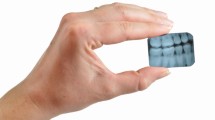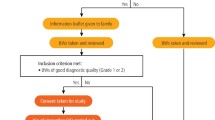Abstract
Introduction Bitewing radiographs (BWs) are under-utilised for children, and reliance on visual diagnosis alone is likely to under-diagnose caries. Quantification of the level of the under-reporting of caries and the vital role of BWs would be beneficial when providing dental care to the paediatric population.
Aim To quantify the diagnostic value of bitewings in the management of proximal caries in primary molars.
Design Cross-sectional study.
Materials and methods Thirty children (mean age 6.2 ± 1.3 years) were recruited. A visual inspection (VI) of the primary molars was carried out and bitewings were taken. Radiographic assessment (RA) for primary molar proximal caries was completed separately. VI and RA were compared statistically against three caries thresholds, using the Fisher's exact test. A p value <0.05 was considered statistically significant. Sensitivity and specificity analyses were performed.
Results A total of 480 proximal surfaces were assessed. Bitewings detected 44.6% of additional proximal carious lesions (p <0.0001). At d3 threshold, VI under-reported 51.2% proximal caries (p <0.0001) and 34.1% dentinal proximal caries (p = 0.0012). VI showed high specificity (99%) and low sensitivity (53%).
Conclusion Bitewings play a vital role in proximal caries diagnoses of primary molars.
Key points
-
Highlights the importance of bitewing radiographs in assessment of carious primary molars.
-
Discusses the prevalence of under-reported proximal caries at the d3 threshold.
-
Describes the role of bitewing radiographs in detecting 'hidden proximal caries'.
This is a preview of subscription content, access via your institution
Access options
Subscribe to this journal
Receive 24 print issues and online access
$259.00 per year
only $10.79 per issue
Buy this article
- Purchase on Springer Link
- Instant access to full article PDF
Prices may be subject to local taxes which are calculated during checkout


Similar content being viewed by others
References
Morgan M, Monaghan N. Picture of oral health 2017: Dental caries in 5 year olds (2015/2016). 2017. Available athttps://www.cardiff.ac.uk/__data/assets/word_doc/0019/801820/Picture-of-Oral-Health-2017_final-report-for-WOHIU-website.docx (accessed December 2020).
Public Health Scotland. National Dental Inspection Programme (NDIP): Report of the 2020 Detailed Inspection Programme of Primary 1 Children and the Basic Inspection of Primary 1 and Primary 7 children. 2020. Available at https://www.scottishdental.org/wp-content/uploads/2020/10/2020-10-20-ndip-report.pdf (accessed December 2020).
Public Health England. National Dental Epidemiology Programme for England: oral health survey of 5-year-old children. 2019. Available at https://www.gov.uk/government/statistics/oral-health-survey-of-5-year-old-children-2019 (accessed December 2020).
Pitts N B. Diagnostic tools and measurements-impact on appropriate care. Community Dentistry and Oral Epidemiology. Community Dent Oral Epidemiol 1997; 25: 24-35.
Banava S, Fattah M, Kharrazifard M et al. Clinical comparison of dental caries by DMFT and ICDA systems. J Islam Dent Assoc Iran 2012; 24: 146-151.
International Caries Classification and Management System (ICCMS). International Caries Classification and Management System (ICCMS). 2018. Available at https://www.iccms-web.com/ (accessed April 2020).
Ekstrand K R, Gimenez T, Ferreira F R, Mendes F M, Braga M M. The International Caries Detection and Assessment System - ICDAS: A Systematic Review. Caries Res 2018; 52: 406-419.
Agustsdottir H, Gudmundsdottir H, Eggertsson H. Caries prevalence of permanent teeth: a national survey of children in Iceland using ICDAS. Community Dent Oral Epidemiol 2010; 38: 299-309.
Fisher J, Glick M, FDI World Dental Federation Science Committee. A new model for caries classification and management: the FDI World Dental Federation caries matrix. J Am Dent Assoc 2012; 143: 546-551.
Pitts N, Chadwick B, Anderson A. Children's Dental Health Survey, Report 2: Dental Disease and Damage in Children England, Wales and Northern Ireland. 2015. Available at https://files.digital.nhs.uk/publicationimport/pub17xxx/pub17137/cdhs2013-report2-dental-disease.pdf (accessed May 2020).
Braga M M, Mendes F M, Ekstrand K R. Detection Activity Assessment and Diagnosis of Dental Caries Lesions. Dent Clin North Am 2010; 54: 479-493.
Nelson S J. Wheeler's dental anatomy, physiology, and occlusion. 9th ed. St. Louis: Saunders, 2009.
Pitts N, Kidd E. Some of the factors to be considered in the prescription and timing of bitewing radiography in the diagnosis and management of dental caries. J Dent 1992; 20: 74-84.
Finucane D. Rationale for restoration of carious primary teeth: A review. Eur Arch Paediatr Dent 2012; 13: 281-292.
BaniHani A, Deery C, Toumba J, Munyombwe T, Duggal M. The impact of dental caries and its treatment by conventional or biological approaches on the oral health-related quality of life of children and carers. Int J Paediatr Dent 2018; 28: 266-276.
Deery C, Owen J, Welbury R, Chadwick B. Dental caries in children and the level of repeat general anaesthetics for dental extractions. A national disgrace. Dent Update 2015; 42: 305-306.
Poorterman J, Aartman I, Kieft J, Kalsbeek H. Value of Bite-Wing Radiographs in a Clinical Epidemiological Study and Their Effect on the DMFS Index. Caries Res 2000; 34: 159-163.
Anderson M, Stecksén-Blicks C, Stenlund H, Ranggård L, Tsilingaridis G, Mejàre I. Detection of approximal caries in 5-year-old Swedish children. Caries Res 2005; 39: 92-99.
Kidd E, Pitts N. A reappraisal of the value of the bitewing radiograph in the diagnosis of posterior approximal caries. Br Dent J 1990; 169: 195-200.
Trevisan T C, de Andrade M C, Presoto C D, Bortolatto J. Hidden caries: A critical review. Sci J Dentistry 2015; 2: 33-36.
Faculty of General Dental Practice (UK). Selection criteria for dental radiography. 2018. Available at https://cgdent.uk/wp-content/uploads/2021/08/FGDP-SCDR-ALL-Web.pdf (accessed September 2018).
Scottish Dental Clinical Effectiveness Programme. Prevention and Management of Dental Caries in Children. 2018. Available at http://www.sdcep.org.uk/wp-content/uploads/2018/05/SDCEP-Prevention-and-Management-of-Dental-Caries-in-Children-2nd-Edition.pdf (accessed September 2018).
Kühnisch J, Anttonen V, Duggal et al. Best clinical practice guidance for prescribing dental radiographs in children and adolescents: an EAPD policy document. Eur Arch Paediatr Dent 2020; 21: 375-286.
Taylor G, Macpherson L. Verifiable CPD paper: An investigation into the use of bitewing radiography in children in Greater Glasgow. Br Dent J 2004; 196: 563-568.
Templeton A R, Young L, Bish A et al. Patient-, organisation-, and system-level barriers and facilitators to preventive oral health care: a convergent mixed-methods study in primary dental care. Implementation Sci 2016; DOI: 10.1186/s13012-015-0366-2.
Flahault A, Cadilhac M, Thomas G. Sample size calculation should be performed for design accuracy in diagnostic test studies. J Clin Epidemiol 2005; 58: 859-862.
Newman B, Seow W, Kazoullis S, Ford D, Holcombe T. Clinical detection of caries in the primary dentition with and without bitewing radiography. Aust Dent J 2009; 54: 23-30.
Clark H, Curzon M. A prospective comparison between findings from a clinical examination and results of bitewing and panoramic radiographs for dental caries diagnosis in children. Eur J Paediatr Dent 2004; 5: 203-209.
Lillehagen M, Grindefjord M, Mejare I. Detection of approximal caries by clinical and radiographic examination in 9-year-old Swedish children. Caries Res 2007; 41: 177-185.
Foster Page L A, Boyd D, Fuge K et al. The effect of bitewing radiography on estimates of dental caries experience among children differs according to their disease experience. BMC Oral Health 2018; DOI: 10.1186/s12903-018-0596-1.
Subka S, Rodd H, Nugent Z, Deery C. In vivo validity of proximal caries detection in primary teeth, with histological validation. Int J Paediatr Dent 2019; 29: 429-438.
Hopcraft M S, Morgan M V. Comparison of radiographic and clinical diagnosis of approximal and occlusal dental caries in a young adult population. Community Dent Oral Epidemiol 2005; 33: 212-218.
ElSalhy M, Ali U, Lai H, Flores-Mir C, Amin M. Caries reporting in studies that used the International Caries Detection and Assessment System: A scoping review. Community Dent Oral Epidemiol 2019; 47: 92-102.
Mendes F M, Novaes T F, Matos R et al. Radiographic and laser fluorescence methods have no benefits for detecting caries in primary teeth. Caries Res 2012; 46: 536-543.
Maguire A, Clarkson J E, Douglas G V A et al. Best-practice prevention alone or with conventional or biological caries management for 3-to 7-year-olds: the FiCTION three-arm RCT. Health Technol Assess 2020; DOI: 10.3310/hta24010.
World Health Organisation (WHO). Oral Health Survey, Basic Methods. 2013. Available at https://apps.who.int/iris/bitstream/handle/10665/97035/9789241548649_eng.pdf?sequence=1 (accessed April 2020).
Marcelle M N, James D B, Qvist V et al. Concordance Between Preoperative and Postoperative Assessments of Primary Caries Lesion Depth: Results From the Dental PBRN. Oper Dent 2010; 35: 389-396.
Acknowledgements
We would like to thank the staff of the Department of Radiology and Department of Paediatric Dentistry, Edinburgh Dental Institute along with participating patients and their parents for all their help and contribution to the study. We would also like to thank Mr Donald J. Thompson, Consultant Oral and Maxillofacial Radiologist, for his assistance in the study.
Author information
Authors and Affiliations
Corresponding author
Ethics declarations
No conflict of interests.
Rights and permissions
About this article
Cite this article
Anwar, A., Keightley, A., Roebuck, E. et al. The value of bitewing radiographs in the management of carious primary molars. Br Dent J 231, 575–579 (2021). https://doi.org/10.1038/s41415-021-3570-2
Received:
Accepted:
Published:
Issue Date:
DOI: https://doi.org/10.1038/s41415-021-3570-2
This article is cited by
-
The value of bitewing radiographs in the management of carious primary molars - the impact on treatment planning
British Dental Journal (2023)



